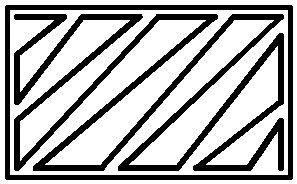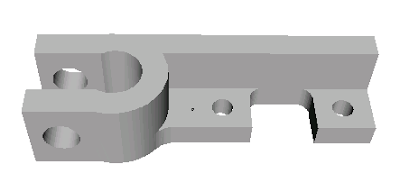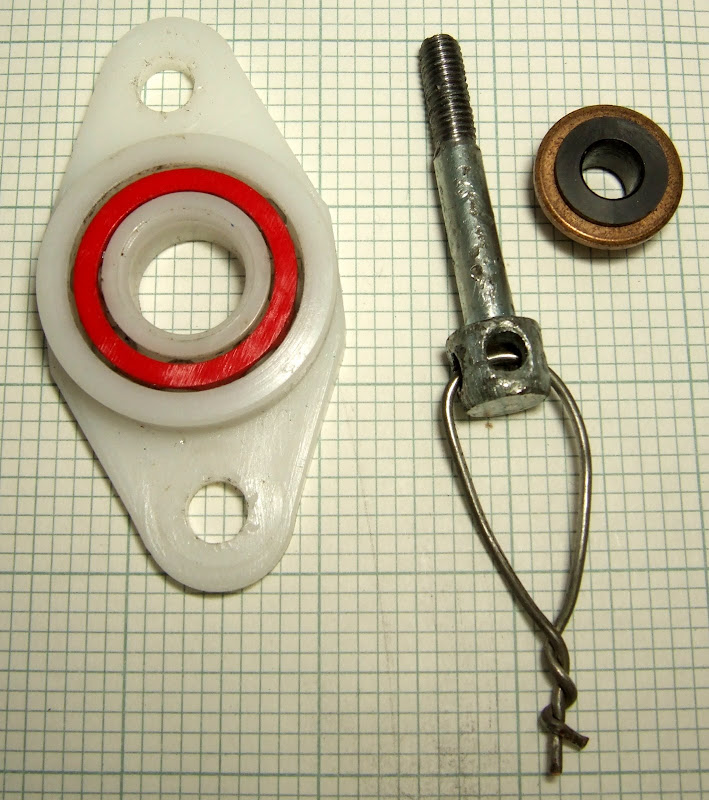
More details here.
I wrote a script that can print n copies of the same object by spacing them out so that the head can get between them. It would be more efficient to print them closer together, one layer of each at a time, but if anything goes wrong then they are all scrap so I am taking the conservative approach at the moment.
With the script I managed three printing shifts in a day. I set off a batch of seven diagonal tie brackets in the morning and they were waiting for me when I got home from work.

I then printed the X-carriage during the evening and another seven diagonal tie brackets during the night.

My wife thinks it looks like a ruined church and I have to agree.
After that things started to go downhill. The flexible drive coupling broke for the third time, but that was easy to replace by soldering in another piece of cable.

The first thing I made when it was back up and running was an old version of the extruder motor bracket which allows a direct drive. At this point the JB-Weld heater insulation started to fall off leaving the heater wire bare. It seemed to miraculously stay in place and still give heat even when most of the JB-Weld had gone.
I did notice the heater duty cycle was going up, eventually reaching 100%, but that was to be expected as there was less thermal conduction from the wire to the barrel. Then the temperature didn't quite make the set point, but it was close so I carried on using the machine. I made three pulleys but they seemed to get too hot. The top was distorted and they were impossible to separate from the raft. I put this down to them being smaller than anything I had made so far and decided to make something bigger. I left the machine making a bed corner bracket and went out for a walk. When I can back the house stank of burning plastic and the bed corner bracket was impossible to separate from its raft, and the raft was welded onto the bed material.

I finally twigged, the reason the temperature was reading low, and hence the heater was full on, was because the JB-Weld holding the thermistor had also decomposed. I don't know what the temperature was but it was way too high.
So I switched to my Cerastil heater and the nozzle from my high temperature extruder experiment. I also had to replace the bed material as it had a big hole in it where I broke off the corner bracket.
I powered it up and calibrated it and it seemed fine. I left it running for a while and it started making popping sounds and producing little clouds of smoke. Very odd, while I was puzzling over it the temperature reading started falling with the heater on. Then clouds of smoke started streaming out of the extruder.
Aha I thought, the thermistor must have come off again, but when I stripped it down I found it hadn't. What actually happened was molten ABS had escaped from the thread of the nozzle and got onto the thermistor. For some reason that must have cooled it, causing it to read low, so the heater overheated again.
I fixed the leak by sealing the thread with PTFE plumbing tape. I set the machine off again but it only got half way through a raft when the heater barrel escaped from the PTFE insulator and the nozzle buried itself into the brand new bed material.
I made a new PTFE barrel (as the old one had obviously been softened by its high temperature excursions) but when I was reassembling it, the thermistor, which was only stuck with JB-Weld, fell off. So back to square one!
I stuck the thermistor back on with Cerastil but when I screwed the nozzle on it was too close, so it broke off again. Starting to get a bit frustrated now, to put it mildly!
I stuck the thermistor on again with Cerastil, this time after I screwed the nozzle on, but while reassembling the extruder for the nth time one of the heater wires broke off. I was able to dig out the connection and solder to it with high temperature solder.
I reassembled the extruder yet again and set the machine going. Half way through the raft the drive shaft broke, not the flexible bit, but the solid bit it was soldered into!
At this point I started to think I was never going to get a working extruder again. A week had passed, I had been working on it every evening but every time I fixed something, something else broke. I had taken it apart and reassembled it so many times that the threads on the M3 studding that tensions the springs had worn away and had to be replaced.
Rather than make a new drive shaft I decided to go for the direct drive design that is slightly shorter. I soldered a nut to the end of the broken shaft and modified the couping in the lathe to shorten it and give it a taper to clear the filament.

So HydraRaptor gets its first RP part.

I now seem to be back up and running and have managed to knock out several more Darwin parts.
Pulleys and belt clamps: -

The belt clamps are the smallest things I have made, they only take about 4 minutes each.
This is the largest thing I have made, I think it is the biggest Darwin part, the X-motor bracket: -

It takes about 4 hours and uses 37cc of plastic when done with 25% fill. That is just less than $1 worth of ABS at the RRRF price of $20/Kg.
I also made four bed corner brackets: -

I can only fit two at a time on the table: -

I found that the mystery bed material I am using has a glass transition below 100C so I think it is PVC plus a filler. I stick it down with double sided tape but larger objects manage to lift it at the edges so I made a frame to hold it down. It is a sheet of 3mm HDPE laminated with aluminium. I milled the aperture in it using HydraRaptor's milling head. The only problem is it restricts the build area slightly because the biggest milling bit I have is smaller than the nozzle.
So it seems the machine is running reliably again and two of the things that persistently fail, flexible drive cable and J-B Weld have been eliminated.
I also made this coat hook for Adrian Bowyer: -

It is Adrian's design, sliced by Enrique's software, extruded though a nozzle made by Adrian. It took about 40 minutes and used about 8g of ABS costing $0.16.









































